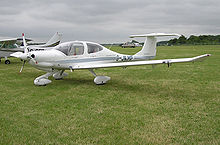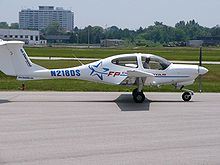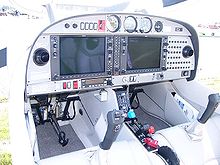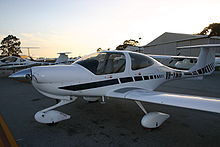- Diamond DA40
-
DA40 Diamond Star Role Light aircraft Manufacturer Diamond Aircraft Industries First flight 5 November 1997 Unit cost $344,950 DA-40XLS (2009 base price)[1] Developed from Diamond DA20 The Diamond DA40 Diamond Star is an Austrian four-seat, single engine, light aircraft constructed from composite materials. Built in both Austria and Canada, it was developed as a four-seat version of the earlier DA20 by Diamond Aircraft Industries.
Contents
Design and development
Based on the success of the earlier DA20 two-seat aircraft, the company designed a four-seat variant, the DA40. The DA40 is a four-seat low-wing cantilever monoplane made from composite materials. It has a fixed nose-wheel landing gear and a T-tail. The Rotax 914 powered prototype DA40-V1, registered OE-VPC, first flew on the 5 November 1997 and was followed by a second prototype DA40-V2 (registered OE-VPE) which was powered by a Continental IO-240. In 1998 a third prototype DA40-V3 flew powered by a Lycoming IO-360 engine. Four more test aircraft were produced followed with the first production aircraft in 2000. JAR23 certification of the IO-360 production variant was obtained in October 2000. In 2002 the production of the Lycoming engined variant was moved to Canada and the Austrian factory concentrated on diesel-engined variants.
The DA40 has only officially appeared in three versions, the DA 40, DA 40D and DA 40F, as documented on its type certificates. The various model names that the aircraft has been sold under are marketing names and are not officially recognized by the authorities that have certified the aircraft.[2][3]
The DA40 was initially marketed as the DA40-180, powered by a fuel injected Textron Lycoming IO-360 M1A engine.[2][3]
In late 2006, the XL and FP models replaced the DA40-180. The FP replaced the fixed-pitch propeller version of the 180 and the XL replaced the constant-speed propeller version. The major difference between the new models and the 180 is the higher maximum cruise speeds. The DA40-XL is approximately four knots faster than the preceding DA40-180/G1000 with the two-blade Hartzell propeller and the "Speed Gear" option. The XL's speed increase is mostly due to the Powerflow exhaust system.
The DA40-XL has a constant-speed propeller and is powered by a 180 hp (130 kW) Lycoming IO-360-M1A fuel injected engine. It has a maximum cruise speed of 147 knots, burning 9.2 gallons of Avgas per hour. Its maximum takeoff weight is 2,535 lb (1,150 kg).[4]
The DA40-F (marketed as the "FP") has a fixed-pitch propeller, a 180 hp (130 kW) Lycoming O-360-A4M engine, which has a carburettor rather than fuel injection and a more basic interior, but is otherwise similar to the XL.[2][3]
The DA40-TDI uses a Thielert "Centurion" 135 hp (101 kW) diesel engine and burns diesel or jet fuel. It has a constant speed propeller and FADEC (single lever) engine control. The first flight of the DA40D was made on Nov. 28, 2002. This model is not certified in the US.[2][3][5]
Efforts to increase the DA40's cruising speed centered on the propeller and wheel spats. The wheel fairing streamlining was improved, a three-blade scimitar-type constant-speed propeller was incorporated and the Powerflow exhaust system from the XL was retained. The canopy contour was also revised, with the sides being more vertical before curving into the roof, which provides more shoulder and head room.
In the last half of 2007 the company updated the DA40 line by introducing the XLS and CS versions and eliminated the FP model. The XLS is the deluxe version, with the integration of some options into the standard offering including a Powerflow tuned exhaust, WAAS-capable G1000, GDL69 datalink, and TAS traffic alert system. The CS is the budget version, with fewer standard features.[6]
Both CS and XLS versions of the DA40 use the Lycoming IO-360-M1A fuel injected engine. The major difference is the choice of propeller, with the CS using a Hartzell two-blade aluminum constant speed prop and the XLS using an MT composite three-blade unit.[2][3]
Pilot and passengers enter the DA40 via the leading edge of the wing, an unusual feature among low-wing aircraft. The aircraft's nosewheel is free-castoring and directional control while taxiing is by mainwheel differential braking.[7]
DA40s are produced at Diamond's aircraft factories in Wiener Neustadt, Austria and in London, Ontario, Canada. A joint venture has also been set up in China with Shandong Bin Ao Aircraft Industries for production of the DA40 in Shandong Province. Capacity is available for up to 1,000 aircraft a year to be produced with certification by the European Aviation Safety Agency in 2008.[8]
Past DA40 models were available with either traditional mechanical instruments or an optional Garmin G1000 glass cockpit suite. Current production DA40s are built only with the Garmin G1000 as standard equipment. In April 2008, Diamond introduced the optional availability of Garmin Synthetic Vision Technology on the DA40 XLS.[9]
Operational history
The DA40 has accumulated a very low accident record, particularly with regard to stall and spin accidents. Its overall and fatal accident rates are one eighth that of the general aviation fleet and include no stall-related accidents. The level of safe operation is attributed to its high aspect ratio wing, low wing loading and benign flight characteristics. The aircraft can be trimmed full nose up, engine set to idle and it will descend at 600-1200 feet per minute at 48 kn (89 km/h) hands-off, a lower rate of decent than the competitive Cirrus SR22 can achieve with its airframe ballistic parachute deployed.[10]
Variants
- DA 40
- Initial model, powered by a Textron Lycoming IO-360 M1A 180 hp (135 kW) engine and a MT Propellers MTV-12-B/180-17. Maximum gross weight is 1150 kg (2535 lb) or 1200 kg (2646 lb) with modifications installed. In increasingly refined versions marketed as the DA40-180, XL, CS and XLS.[2][3][6]
- DA 40D
- Diesel model, powered by a Thielert TAE 125-01 (Centurion 1.7) or TAE 125-02-99 (Centurion 2.0) engine of 135 hp (101 kW) and MT Propellers MTV-6-A/187-129. Maximum gross weight is 1150 kg (2535 lb). Marketed primarily in Europe, although certified in Canada and Australia as well, as the DA40 TDI.[2][3][5]
- DA 40F
- Fixed pitch propeller model, powered by Textron Lycoming O-360-A4M and a Sensenich 6EM8S10-0-63 or a Mühlbauer MT 188R135-4G propeller. Maximum gross weight is 1150 kg (2535 lb). Marketed as the DA40 FP. This model is no longer offered.[2][3]
- T-52A
- Military trainer version, 20 acquired in 2009 and used by the 557th Flying Training Squadron at USAFA[11] The type will be replaced in 2012 with the Cirrus SR20-based T-53A.[12]
Operators
Civil
The aircraft is popular with flying schools and is operated by private individuals and companies.
Military
- Bolivian Air Force - 9 for basic flight training.[13]
- Jamaica Military Aviation School - 2[citation needed]
Specifications (2007 model Diamond DA40 XL Diamond Star)
Data from Diamond Aircraft website[16]
General characteristics
- Crew: 1 pilot
- Capacity: 3 passengers
- Length: 26 ft 5 in (8.1 m)
- Wingspan: 39 ft 2 in (11.9 m)
- Height: 6 ft 6 in (1.98 m)
- Wing area: 145.3 ft² (13.5 m²)
- Empty weight: 1,755 lb (795 kg)
- Loaded weight: 2,645 lb (1198 kg)
- Useful load: 890 lb (403 kg)
- Max takeoff weight: 2,645 lb (1198 kg)
- Powerplant: 1 × Lycoming IO-360-M1A air-cooled, 4-cylinder horizontally-opposed piston engine, 180 hp (134 kW)
Performance
- Cruise speed: 150 knots (173 mph, 279 km/h)
- Stall speed: 49 knots flaps down (56 mph, 91 km/h)
- Range: 720 nm (828 mi, 1341 km)
- Service ceiling: 16400 ft (5000 m)
- Rate of climb: 1120 ft/min (5.69 m/s)
- Power/mass: 14.7 lb/hp (110 W/kg)
References
- ^ Diamond Aircraft Industries (undated). "Diamond DA40". http://www.diamondaircraft.com/build/index.php?id=3. Retrieved 2008-11-23.
- ^ a b c d e f g h Transport Canada (August 2007). "Type Certificate Data Sheet A-224 Issue 7". http://www.tc.gc.ca/aviation/applications/nico-celn/en/getfile_inc.asp?x_lang=e&AFCflag=Y&doc_type=pdf&aprv_num=A-224&isu_num=7&isu_dt_start=2007%2D08%2D17+00%3A00%3A00&proj_num=070092. Retrieved 2008-09-11.
- ^ a b c d e f g h Federal Aviation Administration (October 2007). "TYPE CERTIFICATE DATA SHEET NO. A47CE Revision 9". http://www.airweb.faa.gov/Regulatory_and_Guidance_Library/rgMakeModel.nsf/0/ff82b098d4144df886257379006ed078/$FILE/A47CE.pdf. Retrieved 2008-09-11.
- ^ DA40 XL Fact Sheet
- ^ a b Diamond Aircraft Industries (undated). "DA40 Diamond Star Innovation in Motion". http://www.diamond-air.at/da40_diamond_star+M52087573ab0.html. Retrieved 2008-09-11.
- ^ a b Diamond Aircraft Industries (undated). "DA40 Diamond Star XLS and CS". http://www.diamondaircraft.com/aircraft/da40.php. Retrieved 2008-09-11.
- ^ Flying the Diamond Star XLS, Flying Magazine, Vol. 135., No. 5, May 2008, p. 64
- ^ "News Breaks", Aviation Week & Space Technology, January 1, 2007.
- ^ Diamond Aircraft (April 2008). "Diamond Aircraft introduces Synthetic Vision on DA40 Diamond Stars". http://www.diamondair.com/news/2008_04_08.php. Retrieved 2008-06-11.
- ^ Bertorelli, Paul (15 October 2011). "Fun With Parachute Mode". AVweb. http://www.avweb.com/blogs/insider/AVwebInsider_ParachuteMode_205652-1.html. Retrieved 31 October 2011.
- ^ USAFA (August 2009). "557 FTS Aircraft – T-52A". http://www.aetc.af.mil/shared/media/document/AFD-090825-024.pdf. Retrieved 6 May 2010.
- ^ Associated Press (June 2011). "Academy gets 25 new trainer aircraft for $6.1M". Air Force Times. http://www.airforcetimes.com/news/2011/06/ap-academy-gets-25-new-trainer-aircraft-061611/. Retrieved 17 June 2011.
- ^ New Basic Trainers for Bolivian Air Force, Air Forces Monthly, September 2010, p. 23
- ^ Doss Aviation (December 2008). "Diamond DA40 Selected For USAF Academy Powered Flight Program". http://www.dossaviation.com/page.asp?id=71&name=Dec+2008. Retrieved 2009-04-15.
- ^ The Straits Times (February 2011). "S'pore Youth Flying Club's new Diamond DA-40 planes". http://www.straitstimes.com/BreakingNews/Singapore/Story/STIStory_633764.html. Retrieved 2011-02-11.
- ^ Diamond Aircraft Industries (undated). "Diamond DA40 XLS Specs and Options". http://www.diamondaircraft.com/aircraft/da40_xls/specs.php. Retrieved 2008-10-11.
External links
Diamond Aircraft Industries DV20 Katana · DA20 Katana/Evolution/Eclipse · DA36 E-Star · DA40 Diamond Star · DA42 Twin Star · DA50 Super Star · D-Jet · HK36 Super Dimona
USAAC/USAAF/USAF/Tri-service trainer aircraft Advanced Trainer Basic Combat Basic Trainer Primary Trainer (1924-1948) Trainer (1948-1990) "T-1", "T-2", "T-3" and "T-6" have also been assigned since 1962 in a separate sequence.Lists relating to aviation General Aircraft (manufacturers) · Aircraft engines (manufacturers) · Airlines (defunct) · Airports · Civil authorities · Museums · Registration prefixes · Rotorcraft (manufacturers) · TimelineMilitary Accidents/incidents Records Categories:- Austrian civil utility aircraft 1990–1999
- Canadian civil utility aircraft 2000–2009
- Diamond aircraft
- Single-engine aircraft
Wikimedia Foundation. 2010.








